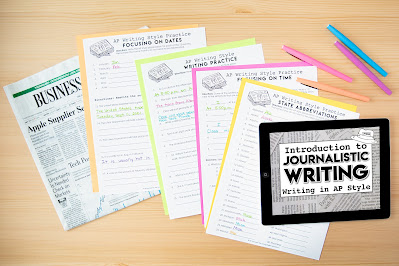Welcome to the amazing world of teaching journalism and advising the school newspaper! Whether you’ve signed up to teach journalism or were assigned the class, teaching students journalism and advising the school newspaper can be a gratifying aspect of your career. In this post, I will share my top tips for new journalism advisers.
High school journalism holds a special place in my heart. I was on the newspaper staff all four years of my high school career, eventually serving as my school paper’s editor-in-chief and studying journalism in college. And now, I continue my work in scholastic journalism by teaching journalism at my school.
Coming in as a new or first-time journalism adviser can be daunting, especially if you have no prior journalism experience. If you are looking for a great teaching resource to get you started, my journalism teaching unit has enough materials to get you started.
Here are ten tips for new journalism advisers.
1. Tips for New Journalism Advisers: Join scholastic journalism organizations
One of the best ways to become more acquainted with scholastic journalism is by joining professional organizations. My favorite professional organization is JEA, the Journalism Education Association. Another good organization is the Columbia Scholastic Press Association. These organizations help advisers by sharing curricula, ideas, and contests.
2. Tips for New Journalism Advisers: Become familiar with the inverted pyramid
 Unlike traditional essay and academic writing, journalistic writing follows a different format. For s typical news story, student journalists should follow an inverted pyramid format their stories where they include the who, what, where, and when in the lead, or lede, within the first paragraph of the story.
Unlike traditional essay and academic writing, journalistic writing follows a different format. For s typical news story, student journalists should follow an inverted pyramid format their stories where they include the who, what, where, and when in the lead, or lede, within the first paragraph of the story.
One of the biggest struggles I see new student journalists face is trying to write an eloquent, English essay-style introduction for their news stories. Instead, students should keep it simple and report the straight facts. In my classroom, I use this News Lead lesson plan and these journalism graphic organizers to help my students become more familiar with the inverted pyramid.
3. Tips for New Journalism Advisers: Start with the basics (5W and H)
Once my students have their assignments, I have them begin working on their story packages. Since we publish both online and in print (not all stories make it to print, though), a story package contains everything that the editors will need to be able to publish the story. One of the elements of the story package is the 5Ws and H.
On their document, students write out WHO, WHAT, WHERE, WHEN, WHY and HOW, and then they complete each item with information from the story. This brainstorming activity is especially helpful for new journalists because it helps them stick to the inverted pyramid.
4. Tips for New Journalism Advisers: Review AP style
 As English teachers, we know MLA format; however, writing for journalism is different, and students need to learn and use AP Style instead. To help my students learn AP Style, I keep several copies of the AP Stylebook in my classroom.
As English teachers, we know MLA format; however, writing for journalism is different, and students need to learn and use AP Style instead. To help my students learn AP Style, I keep several copies of the AP Stylebook in my classroom.
I also use this AP Style Writing Unit which covers the essential elements of AP style that students need. I also ensure that my editors are well-versed in AP Style and help out the newer staff members as they learn to write like journalists.
5. Tips for New Journalism Advisers: Know your students’ rights
As decided in Tinker v. Des Moines Independent Community School District, students do not “shed their constitutional rights to freedom of speech or expression at the schoolhouse gate.” This landmark ruling is beneficial for student journalists.
One of the best things you can do as a new adviser is to learn your students’ rights. The Student Press Law Center is an excellent resource for this.
6. Tips for New Journalism Advisers: Focus on instruction before worrying about publication
One of the biggest mistakes I made as a new journalism adviser was jumping right into publication before the students were ready. I took journalism all four years of high school and majored in it in college. I knew how to write journalistically, but my students did not.
Since I rushed to publish content that first year, I spent so much time helping students revise their stories to fit journalistic standards. In the long run, it took more time than starting with the curriculum at the start of the year.
Now, I use the lessons in my Journalism Curriculum to help my students learn how to write like journalists before we press publish.
Teaching Journalism: An All-in-One Journalism Curriculum
My journalism curriculum has everything you need to get your journalism students started on the right foot and working on a successful newspaper -whether you publish in print or digitally!
From learning basic journalism terminology to news writing to the inverted pyramid to AP Style writing, this curriculum has everything you need to get your student journalists writing and publishing high-quality news stories. This journalism curriculum works for both middle school journalism and high school journalism.
This is the curriculum that I use in my classroom with my students.
JOURNALISM ADVISERS LIKE YOU SAID…
⭐️⭐️⭐️⭐️⭐️ Doreen T. says, “This helped me SO MUCH with the first journalism class I’ve ever taught. The powerpoints are amazing – very informative, thorough, and visually appealing. Not sure what I would have done without this resource! .”
⭐️⭐️⭐️⭐️⭐️ Midwestern Miss says, “Omgoodness! As a teacher who hasn’t taught journalism in 8 years, this saved me! I was able to print and go. The kids loved being able to create their own AP mini books and were laughing at each other’s crafting abilities. Bringing some artistic time into the room before we start the yearbook!”
⭐️⭐️⭐️⭐️⭐️ Geneva W. says, “Thank you for this amazing resource! I am teaching a journalism class for the second time this year. Last year I bought a few of your lessons, but this year I splurged on the whole package, and I am so thankful that I did! It really has been an essential part of building my journalism class. Pretty much everything is taken care of for me, and I feel confident in presenting the materials even though journalism is not my strength.”
7. Tips for New Journalism Advisers: Utilize student editors
The ultimate goal of any student-run publication should be to have the students choose the content, write the stories, edit the stories, design the print issues, and publish the online content. However, when you are just starting, especially if it is a newer program on your campus, that can be challenging. Try to build the program each year while utilizing student editors to help the publication run.
I have my section editors (news editor, sports editor, etc.) assign stories to new students, check-in on the stories, and edit the stories before I even see them. Not only does this help alleviate the workload, but it also gives students more ownership of the publication.
8. Tips for New Journalism Advisers: Start small
When you are just starting, all of the tasks might seem too much. If you are starting from scratch, have a relatively new staff, or don’t have much of a clue as to what you are doing right away, start small: decide on print or online. From there, focus on what is realistic for you and your staff to accomplish.
I had to bring the program back during my first year advising the newspaper. The school where I started teaching didn’t have a newspaper, and I knew I wanted to change that. I recruited enough students to get the class on the schedule and was essentially starting from scratch. We started publishing online-only first. In the second year, we incorporated print issues but only completed two eight-page issues a year.
As a new journalism adviser, it is okay to start small. If you are a new adviser for an established program, lean on those student editors. They will be your biggest asset.
9. Tips for New Journalism Advisers: Keep accuracy and fairness above all 
The most important thing is to strive for accuracy and fairness in everything you publish. From day one, all of your students should know just how important accuracy and fairness are, and in every single story, students need to reflect journalistic integrity. Writing stories free from bias will help your program gain credibility and respect, especially with your coworkers and admin.
10. Tips for New Journalism Advisers: Celebrate your students
When it comes to advising student publications, comparison is the thief of joy. It is always so easy to look at other student publications and feel inadequate, like an imposter. As a new adviser, it is essential to avoid that pitfall. Instead, celebrate your students. Celebrate the first published story of the year.
Celebrate each print issue. Celebrate your students’ work, and share it with colleagues. When colleagues send praises your way, relay those messages to your students. After each print issue (we only do 3-4 a year because our main focus is online – again, it is okay to go small), we celebrate with a staff potluck.
The students work so hard during deadlines and in the days leading up to sending the paper off to print that the class celebration is a very welcomed class tradition.
And once you are ready to move on to more journalistic features, check out this blog post about five journalism assignments and activities to assign!


